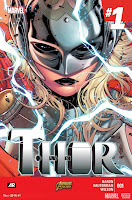Thor #1
By Jason Aaron, Russell Dauterman, Matthew Wilson, Joe Sabino, Frank Martin, Sara Pichelli, Laura Martin, Esad Ribic, Andrew Robinson, Alex Ross, Fiona Staples, Skottie Young.
Thor created by Stan Lee, Larry Lieber, Jack Kirby.
The new status quo for the latest Thor series relaunch begins with the Asgardians assembled on the surface of the Moon to watch a moping thunder god. Having recently returned from yet another period of self-imposed exile, Odin finds his son hunched over his magic hammer Mjolnir, inexplicably no longer worthy of lifting it. His response to this sight is to blame his wife and interim leader Freyja for letting the emasculation of one of Marvel’s manliest heroes happen on her watch. This bit of dickishness being exhibited by one of the publisher’s more awful father-figures provides a not too subtle setup for the grand entrance of a much publicized, all new, unmistakably female Thor. But she only makes an appearance at the very end of the issue, so the reader’s denied the great pleasure of witnessing Odin’s horrified reaction.
What this issue does offer is a cantankerous Odin and sharp-tongued Freyja trading verbal barbs (in which she usually gets the better of the exchanges), Malekith behaving like a complete sociopath by happily tormenting a couple of mere mortals, and Thor acting depressed until he’s snapped out of his funk by the call to action. Always be the hero, even if only an unworthy one. While previous artist Esad Ribic drew in a more classic fantasy vein, Russell Dauterman finds a balance between the fantasy and superhero approach, which suits the demands of the story. His facility with faces allows him to portray perhaps the most emo version of Thor I’ve encountered in the series. And he seems comfortable recreating a variety of sci-fi and fantasy settings, whether deep space or the bottom of the ocean, immortal gods, frost giants, or killer sharks. He’s capably aided by colorist Matthew Wilson, who keeps everything bright and saturated with judicious use of a limited palette tied together by carefully shaded blues, greens, reds and yellows. Probably my favorite panel is a two-page spread portraying in dramatic panorama an army of giants attacking an undersea base, their skin faintly illuminated by the artificial lights. This is a comic of high stakes realized in the widescreen format.
Discovering someone other than Thor who can lift Mjolnir has become a bit cliched at this point. But if you don’t count alternate continuities, the candidates have all been invariably male. Writer Jason Aaron emphasizes the significance of this point through revealing some of the misogyny found within Asgardian society. Putting gender roles aside, the story does strongly imply that the new Thor is a supporting cast member who’s decided to step up to the big leagues. But unless her identity is quickly revealed next issue, this could be a form of misdirection.
Chilling Adventures of Sabrina #1
By Roberto Aguirre-Sacasa, Robert Hack, Jack Morelli.
Sabrina the Teenage Witch by George Gladir, Dan DeCarlo, Rudy Lapick, Vincent DeCarlo.
Sabrina the Teenage Witch’s various media adaptations have tended to play to the Disney Channel/Nickelodean/ABC crowd through employing inoffensive tween humor. By contrast, her first appearance in the short story written by George Gladir and drawn by Dan DeCarlo portrays a character with a sinister edge to her. She’s been tasked to interfere with the lives of her fellow high school students, which she does by making them fall in love with each other, or by altering the outcome of various sporting events. As dastardly acts go, it’s still relatively innocuous stuff. But that darkness at the heart of the character forms the basis for this latest, horror-driven, reimagining of her.
Visually, Chilling Adventures of Sabrina smartly moves away from the seductive imagery of the legendary DeCarlo by using more realistically drawn figures. Robert Hack’s heavily textured surfaces and inky blotches certainly imbue the otherwise bucolic setting in an uncomfortable, claustrophobic haze, making everything look like they're covered in soot. Adding to the level of uneasiness is the intense yellow and orange color scheme. The whole story sometimes looks like it’s set on Mars, or a post-apocalyptic desert landscape. Everyone shambles around like zombies. Nothing about this world would make me want to live in it.
If I have one complaint, it’s that Hack still doesn’t have a firm grasp on the characters yet, especially the main protagonist. Sabrina’s jawline and eyes keep changing every few panels, and that’s pretty distracting.
Storywise, this issue jumps around a lot, feeling a little disjointed in places. It starts with an origin tale featuring Sabrina’s parents, followed by a montage of Sabrina’s upbringing, ending with her first day in Greendale High School. Many of the classic supporting characters are introduced from aunts Hilda and Zelda, cat familiar Salem, cousin Ambrose, school crush Harvey, and teenage rival Rosalind. In keeping with the horror angle, the witches worship Satan, practice the dark arts, and are casually cruel to mortals. Sabrina herself comes across as a mostly amoral figure with a touch of Carrie and the Anti-Christ. There’s this unexpected subplot involving two famous Riverdale characters being members of another coven that’s largely disconnected from Sabrina's narrative. But the creepy cliffhanger raises some questions as to how the supernatural is supposed to interact with the mundane world.


